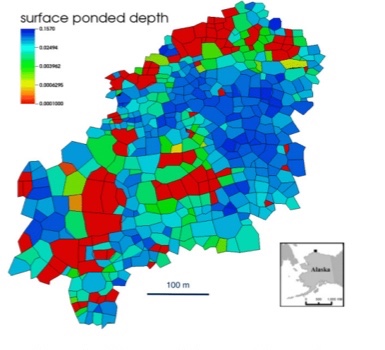

NGEE Arctic
Next-Generation Ecosystem Experiments
Advancing the predictive power of Earth system models through understanding
of the structure and function of Arctic terrestrial ecosystems
Intermediate Model Overcomes Computational Costs of Simulating Thermal-Hydrology for Polygonal Landscapes
Intermediate Model Overcomes Computational Costs of Simulating Thermal-Hydrology for Polygonal Landscapes
September 1st, 2017
Modeling approach improving representations of permafrost dynamics in evolving landscapes.
The Objective:
- Develop an intermediate-scale modeling approach to help bridge the gap between field and laboratory observations and the scale of a regional or global model grid cell.
New Science:
- Enables permafrost dynamics including thaw-induced subsidence to be applied across the Arctic, thus improving representations of permafrost dynamics in evolving landscapes. Capabilities are being used to develop improved parameterizations and computational approaches for use in Earth system models.
The Impact:
- Leveraged fine-scale modeling tools and replaced a computationally difficult three-dimensional system with a novel multiscale model structure.
- The approach was shown to accurately approximates the fully-resolved solution but at a significantly lower computational cost.
Snapshot from an intermediate-scale integrated surface/subsurface thermal hydrology simulation, showing subcatchment variability in surface water depth. Simulations at this scale using advanced soil physics models were not feasible prior to the development of the multi-scale model.
